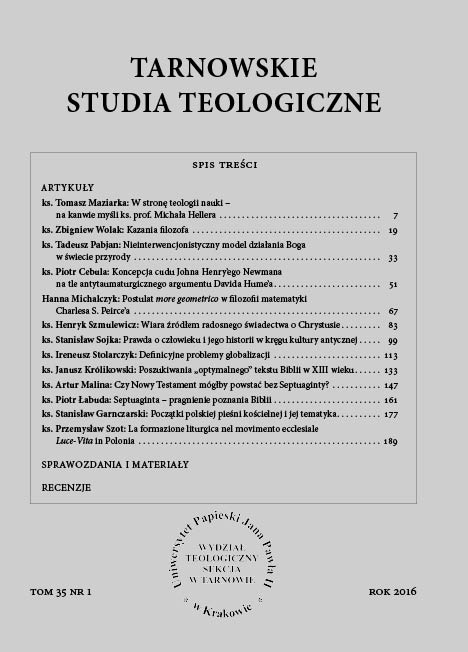Beginnings of the polish church chant and its themes
DOI:
https://doi.org/10.15633/tst.1722Keywords:
Polish chant, liturgy, Latin hymnodia, kierleszAbstract
Polish church chant, monodic and designed for people is an important part of the great heritage of religious culture of the Polish Church. Its appearance was in the scientists research explained by many theories. It is commonly assumed that the most likely formed in the thirteenth century. The first analyzed theory derives it from so called kierlesz, phonetically transformed into a short formula Kyrie eleison, sung on various occasions. However, except for a few cases, you do not hear anything in Poland about kierlesz. Feicht – the opponent of kierlesz theory – preferred source of Polish song is the introduction of recitation in Polish prayers on Sundays and holiday, right after the reading of the gospel. However, these practices can be regarded as a preliminary stage that paves the way for Polish chants. The dominant theory is saying that the source of the song in Poland is Latin hymnodia, translated more or less accurately into Polish. The creation of Polish religious chant was primarily due to the demand of the faithful for religious rites, both beyond the liturgical, and in the liturgy itself. The first chants in Polish represented Easter chants, Passion chants and Marian chants.References
Brückner A., Literatura religijna w Polsce średniowiecznej, t. 1, Kazania i pieśni, Warszawa 1902.
Brückner A., Średniowieczna pieśń religijna polska, Kraków 1923.
Feicht H., Studia nad muzyką polskiego średniowiecza, red. Z. Lissa i in., Kraków 1975.
Fijałek J., Bogurodzica, „Pamiętnik Literacki” 2 (1903), s. 1–27, 163-191, 353–378.
Garnczarski S., Polska pieśń adwentowa w drukach od XVII do XX wieku, cz. 1, Tarnów 2014.
Gromnicki T., Synody prowincyonalne, Kraków 1885.
Grudziński K., Najstarsze zabytki rękopismienne języka polskiego w zbiorach bernardyńskich (do poł. XVI w.), „Archiwa, Biblioteki i Muzea Kościelne” 4 (1962), s. 357–362.
Hinz E., Zarys historii muzyki kościelnej, Pelplin 2000.
Kantak K., Bernardyni polscy, t. 1, Lwów 1933.
Lewański J., Dramat i dramatyzacje liturgiczne w średniowieczu polskim, [w:] Musica Medii Aevi, red. J. Morawski, t. 1, Kraków 1965, s. 96–174.
Maciejowski W. A., Kronika Boguchwała i Godysława Paska, [w:] Monumenta Poloniae historica, wyd. A. Bielowski, t. 2, Lwów 1872, s. 454–598.
Pawlak I., Muzyka liturgiczna po Soborze Watykańskim II w świetle dokumentów Kościoła, Lublin 2001.
Skop G. M., Powstanie i rozwój polskich pieśni religijnych do poł. XVI w. Studium muzykologiczne, 1972 (praca magisterska w Archiwum KUL).
Wisłocki W., Katalog rękopisów Biblioteki Jagiellońskiej, Kraków 1881.
Downloads
Published
Issue
Section
License
Copyright (c) 2016 Stanisław Garnczarski

This work is licensed under a Creative Commons Attribution 4.0 International License.
Authors who publish with this journal agree to the following terms:
- Authors retain the copyright and full publishing rights without restrictions, and grant the journal right of first publication with the work simultaneously licensed under a Creative Commons Attribution 4.0 International License that allows others to share the work with an acknowledgement of the work's authorship and initial publication in this journal.
- Authors are able to enter into separate, additional contractual arrangements for the non-exclusive distribution of the journal's published version of the work (e.g., post it to an institutional repository or publish it in a book), with an acknowledgement of its initial publication in this journal.
- Authors are permitted and encouraged to post their work online (e.g., in institutional repositories or on their website) prior to and during the submission process, as it can lead to productive exchanges, as well as earlier and greater citation of published work (See The Effect of Open Access).

